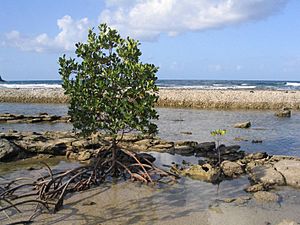Habit (biology) facts for kids
Habit in biology is a cool way to talk about the shape or behavior of animals and plants. It also describes how they live and act in their environment.
Contents
Plant Shapes and Growth
The way plants grow creates their unique shape, which we call their "habit." This is why you can often tell different trees apart just by looking at their overall shape, even from far away! For example, a willow tree has a very distinct, often drooping shape, while a poplar tree usually grows tall and narrow. These shapes develop as the plant grows over time.
Even tiny living things like Bacteria and fungi have their own special ways of growing. This also forms their "habit."

Being a tree is also a type of "lifestyle" or "habit" compared to being a shrub or an annual plant. Trees grow tall and occupy a different space in the ecosystem than smaller shrubs or climbing plants. Each plant's habit helps it survive and thrive where it lives.
Animal Behaviors and Lifestyles
In zoology, "habit" often means a specific behavior that an animal species does regularly. It's like a routine or a common way of acting.
What is a "Habit"?
Here are some examples of animal habits:
- A cat might have the habit of jumping on the door knocker to get inside.
- The spider monkey has an arboreal habit, meaning it mostly lives in trees and rarely goes down to the forest floor.
- A brittlestar has the habit of breaking off its arms. This is a clever way to protect itself from predators.
Different Ways of Living
Sometimes, "habit" can also refer to an animal's "mode of life" or "lifestyle." This describes how an animal lives and interacts with its environment.
Here are some terms that describe different animal habits or lifestyles:
- Motile: Animals that can move around freely.
- Sessile: Animals that stay attached to one spot, like a barnacle.
- Sedentary: Animals that don't move much, even if they can.
- Free-living: Organisms that don't depend on another organism for survival.
- Parasitic: Organisms that live on or in another organism and get their food from it.
- Saprophyte: Organisms (like some fungi or bacteria) that get nutrients from dead or decaying matter.
- Terrestrial: Animals that live on land.
- Arboreal: Animals that live in trees.
- Aquatic: Animals that live in water.
- Pelagic: Animals that live in the open ocean, away from the bottom.
- Diurnal: Animals that are active during the day.
- Nocturnal: Animals that are active at night.
Images for kids
See also
 In Spanish: Hábito (botánica) para niños
In Spanish: Hábito (botánica) para niños




